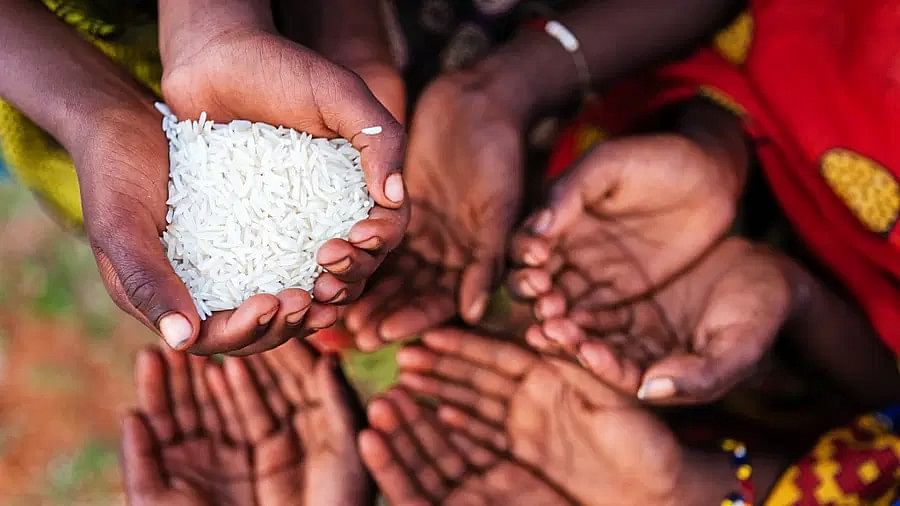
The report highlights that in 2020-2022, the prevalence of undernutrition (PoU) in South Asia was 15.9 per cent.
Credit: iStock Photo
The United Nations’ Food and Agriculture Organization (FAO)’s latest report, ‘Asia and the Pacific - Regional Overview of Food Security and Nutrition 2023, has again drawn attention to hunger and under-nutrition faced by a large section of the population in the region, especially in South Asia which has 85 per cent of undernourished people in the Asia and the Pacific region. This is 314 million people.
Like the other reports of the FAO on this subject, this one is also focused on malnutrition of children resulting in stunting, wasting, and the rising incidence of overweight among children.
The report highlights that in 2020-2022, the prevalence of undernutrition (PoU) in South Asia was 15.9 per cent. Afghanistan faced the worst scenario with 30.1 per cent population being affected. It was followed by Pakistan which had 18.5 per cent population in the same category. India’s situation at 16.6 per cent was worse than Nepal and Sri Lanka (about 5.3 per cent) and Bangladesh (11.2 per cent).
The PoU seeks to capture undernourishment by estimating the share of the population with insufficient calorie intake. Experts such as Professor Sonalde Desai have questioned the FAO’s methodology of capturing the PoU.
In the absence of large data sets like census or consumption expenditure survey, it cannot be said with certainty that the FAO’s assessment of the PoU in India correctly captures the ground reality.
Under the National Food Security Act 2013, about 810 million households were getting wheat and rice at Rs 2 and Rs 3 per kilogram. During the Covid-19 pandemic the Union government doubled the allocation from 5 kg/person to 10 kg/person. However, in the absence of a consumption expenditure survey, it is not known if the poor households used their savings on the purchase of grains to buy other nutritious food such as proteins (eggs, soya, cheese, pulses, meat, fruits, vegetables, etc.).
There is no dispute about some improvement in major indicators of child nutrition in India. The most comprehensive survey available in India is the National Family Health Survey-5 (2019-2021). As compared with the previous NFHS-4 (2015-2016), there has been improvement in infant and child mortality rates. Stunting has reduced from 38.4 per cent to 35.5 per cent, wasting has reduced from 21 per cent to 19.3 per cent, and the prevalence of underweight has reduced from 35.8 per cent to 32.1 per cent.
But all-India figures conceal the worsening situation in several states. For example, child stunting increased in Telangana, Gujarat, Kerala, Maharashtra, and West Bengal. Similarly, the incidence of underweight children went up in Assam, Gujarat, Kerala, Maharashtra, Telangana, and West Bengal.
Similarly, the incidence of anaemia in women rose from 53 per cent to 57 per cent. For children also, anaemia rose from 59 per cent (between six and 59 months) in 2015-2016 to 67 per cent by 2019-2021.
The challenge of anaemia is being addressed by the government by fortification of rice under the National Food Security Act (NFSA). The Food Corporation of India (FCI) has been supplying iron-fortified rice in 15 states, including Andhra Pradesh, Chhattisgarh, Jharkhand, Gujarat, Maharashtra, Tamil Nadu, and Uttar Pradesh. There have been reports in the media about poor acceptability of fortified rice as the iron-rich grains look and feel different. A concurrent evaluation, especially in Chhattisgarh and Jharkhand, is needed as there is a possibility of harm to patients with thalassemia and sickle cell anaemia which are prevalent in parts of these states. The Supreme Court of India is hearing a petition on this.
The answer to better nutrition and, therefore, improved indicators lies in the purchasing power of households. We now have the data from at least one large state.
The caste census report of Bihar (November 10) reveals that 34.1 per cent of households earn less than Rs 6,000 per month. Another 29.6 per cent earn between Rs 6,000 to Rs 10,000 per month. Thus, 63.7 per cent of households earn less than Rs 10,000 per month.
As of November 2021, as per the e-Shram data, 92.37 per cent of informal workers earned Rs 10,000 or below per month.
As per a CRISIL report of November, the cost of a vegetarian thali was Rs 30.3 while the same for non-vegetarian thali was Rs 61.2. Double digit inflation in wheat, rice, pulses, and several vegetables would be making nutritious food unaffordable for a large section.
Can a household earning less than Rs 10,000 per month afford nutritious food, even for a five-member family?
In the absence of government data, it is time for large corporates to provide funds for research so that the impact of various direct transfers to the poor and their impact on nutrition are better documented.
Siraj Hussain, a former Union Agriculture Secretary, a trustee of World Food Programme Trust for India.
(Disclaimer: The views expressed above are the author's own. They do not necessarily reflect the views of DH).